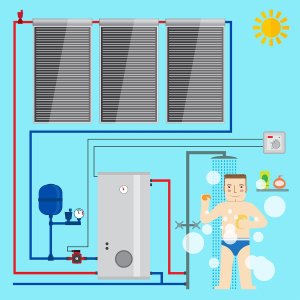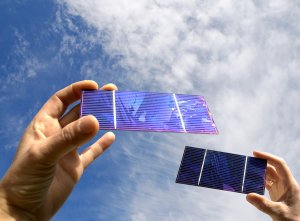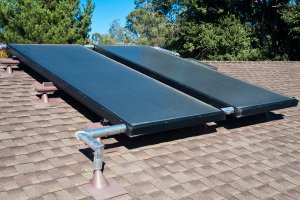-
Sun Bandit Solar Hot Water System Basics
When you are shopping for a new water heater for your home, you may want to check out the innovative products from Sun Bandit . The Sun Bandit line of solar water heaters will provide you with hot water on demand, while also harnessing the power of the sun. These state of the art solar water heater systems are equipped with hybrid solar energy systems that are extremely efficient and effective. A company that specializes in solar hot water installations near Clermont will be able to answer your questions about the benefits of this type of water heating system. Read on for more information about the basics of a Sun Bandit solar water heater.

Hybrid Solar Technology
At the core of the Sun Bandit solar hot water heater is a hybrid solar technology system. Unlike a conventional solar hot water heater, which relies on traditional solar panels to heat water, a Sun Bandit unit is equipped with state of the art photovoltaic panels. These panels transfer the energy of the sun into your hot water heater, resulting in clean and efficient water heating technology.
Easy Installation
A top advantage of a Sun Bandit solar water heater is that this type of water heater is very easy to install. In fact, the installation process for a Sun Bandit water heater is similar to that of a conventional unit. When you choose a Sun Bandit water heater for your home, you can rest assured that your technician will be able to install your unit with a few simple and easy steps.
Simple Maintenance
Finally, the Sun Bandit system is very easy to maintain. Sun Bandit has designed their solar water heaters to have no moving parts and very few external components. As a result, there are very few failure points throughout the system. If you are seeking a solar water heater that will provide you with total peace of mind, you may want to check out the models that Sun Bandit has to offer you.
-
Looking Back at the History of Solar Power
If you’ve heard about the benefits of solar power near The Villages and North Central Florida, you may be interested in learning that the use of solar energy is not a new concept. In fact, people have been harnessing the sun’s power for centuries.
Solar Ovens
Solar-powered ovens rely on the sun’s heat to warm foods and drinks. The first known use of solar ovens occurred in 1767. The invention of a Swiss physicist by the name of Horace de Saussure, these solar ovens consisted of an insulated box fitted with three layers of glass that were used to collect and trap heat. Today, solar ovens are popular in locations where electricity is difficult to access, and are powered by sunlight alone.

Solar Electricity
In the year 1873, Willoughby Smith, an English engineer, discovered that selenium, a chemical element, demonstrated photoconductivity (increased electrical conductivity in the presence of light) while in its solid form. Three years later, Professor William Grylls Adams and his student Richard Evans Day were the first to see an electrical current move through a material that was exposed to light after they attached electrodes to a plate of selenium.
Solar Radiation
Although it is one of his lesser-known achievements, Albert Einstein was awarded the Nobel Prize for his formulation of the photon theory of light. Developed in 1905, the theory describes how the photons contained in solar radiation can transfer their energy on a metal surface.
Solar Cells
Also referred to as photovoltaic cells, solar cells are devices which convert solar radiation into electricity. The first designs for solar cells were created by the American inventor Charles Fritts in 1883. However, it was three researchers from Bell Labs by the names of Calvin Fuller, Gerald Pearson, and David Chaplin who are credited with the creation of the world’s first solar cells in 1954. Over the following years, they managed to improve their device’s conversion efficiency from 4% to 11%. Their first successful trial using the cells in solar panels occurred in 1955, and Bell Labs later supplied solar power for one of NASA’s Vanguard satellites in 1958.
-
Understanding How a Solar Water Heater Works
Are you interested in harnessing solar energy to power your home? A solar hot water system near Clermont and North Central Florida can prove to be a cost-effective and energy-efficient method of providing your household with hot water. This type of system is fueled by solar power alone and can be used in any climate.

Active Solar Water Heaters
A solar water heating system consists of solar collectors and storage tanks. These heating systems fall into two categories: active and passive. Active systems utilize circulating pumps and controls, and can be either direct or indirect. Direct circulation systems function best in climates that rarely reach freezing temperatures, and their pumps circulate water into the home through the collectors. Indirect circulation systems are a popular choice in colder regions that tend to reach freezing temperatures. These systems heat the water flowing into the home using a non-freezing heat-transfer fluid.
Passive Solar Water Heaters
Often less costly but also less efficient than active systems, passive solar water heaters do not use circulating pumps and rely upon one of two other systems instead. Integral collector-storage passive systems are best suited for areas that do not freeze. The second option, thermosiphon systems, are typically more expensive and reliable. These heaters depend on the rising of hot water to the top of the storage tank so it can be pumped into the home.
Solar Water Heater Collectors
The collector’s role is to absorb the sun’s energy that is to be transferred to the water. The three types of collectors used residentially include flat-plate, integral, and evacuated-tube. Flat-plate collectors are weatherproofed and insulated boxes that use a dark absorber plate. Integral collector systems feature black tubes or tanks within an insulated box. Cold water passes through the collector, is heated, and is then pumped into the backup water heater. Evacuated-tube solar collectors consist of clear, glass tubes which contain a metal absorber tube. Attached to the metal is a fin whose coating absorbs the solar energy to transfer heat to the water.
RECENT POSTS
categories
- Uncategorized
- Solar
- Pool Heating
- Solar Pool Heaters
- Solar Panel
- Solar Attic Fans
- Solar Tubular Sky Lights
- About Us
- Infographic
- Solar Cells
- Solar Water Heater
- Tax Benefits
- Solar Powered Lights
- Solar Tubes
- Solar Power
- Solar Company
- Hot Water System
- Sun Bandit
- Solar Energy System
- Solar Electric Power
- Skylight Installation
- PV Systems
- Solar Pool
- Solar Attic Fan
- Solar Fan
